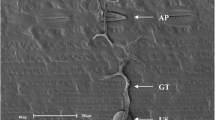Abstract
Lesion fragments from a resistant and a susceptible wheat infected with Pyrenophora tritici-repentis were placed on water agar. Frequency of isolation from both wheats increased similarly with lesion age. The widths of hyphae at the point of emergence from fragments increased with lesion age in the susceptible cultivar only. Diameters of 24-h-old mycelial colonies in the agar around fragments decreased with lesion age in the resistant line only. This indicates a diminishing vigour of hyphae in this line, possibly resulting from the accumulation of an inhibitory factor. In further experiments, fragments of lesions and uninoculated leaves were incubated for 2 h in water or nutrient solutions before conidia were added and germtube lengths assessed 4 h later. Uninoculated leaves were stimulatory to germ-tube growth. Lesions prevented this stimulation, indicating the presence of a post-infection inhibitory factor.
Similar content being viewed by others
References
Bailey, J.A. and Mansfield, J.W. (Eds) (1982) — Phytoalexins. Blackie: Glasgow.
Blakeman, J.P. (1973) — The chemical environment of leaf surfaces with special reference to spore germination of pathogenic fungi. Pesticide Science 4: 575–595.
Cochrane, V.W. (1958) — Physiology of Fungi. Wiley: New York.
Deverall, B.J. and Vessey, J.C. (1969) — Role of a phytoalexin in controlling lesion development in leaves of Vicia faba after infection by Botrytis spp. Annals of Applied Biology 63: 449–458.
Evans, R.L. and Pluck, D. (1978) — Phytoalexins produced in barley in response to the halo spot fungus Selenophoma donacis. Annals of Applied Biology 89: 332–336.
Keeling, B.L. and Banttari, E.E. (1975) — Factors associated with the resistance of barley to Helminthosponum teres. Phytopathology 65: 464–467.
Lwghman, R. and Deveran, B.J. (1986) — Infection of resistant and susceptible cultivars of wheat by Pyrenophora tritici-repentis. Plant Pathology 35: 443–450.
Spendley, P.J., Bird, P.M., Ride, J.P. and Leworthy, D.P. (1982) — Two novel antifungal alka-2, 4-dienals from Triticum aestivum. Phytochemistry 21: 2403–2404.
Tomas, A. and Bockus, W.W. (1987) — Cultivar specific toxicity of culture filtrates of Pyrenophora tritici-repentis. Phytopathology 77: 1337–1340.
Trivedi, N. and Sinha, A.K. (1978) — Production of a fungitoxic substance in rice in response to Drechslera infection. Transactions of the British Mycological Society 70: 57–60.
Wahlroos, D. and Virtanen, A.I. (1959) — The precursors of 6-methoxybenzoxazolinone in maize and wheat plants, their isolation and some of their properties. Acta Chemica Scandinavia 13: 1906–1908.
Author information
Authors and Affiliations
Rights and permissions
About this article
Cite this article
Loughman, R., Deverall, B.J. Experiments with excised lesions from wheat leaves infected by Pyrenophora tritici-repentis . Australasian Plant Pathology 18, 90–93 (1989). https://doi.org/10.1071/APP9890090
Received:
Accepted:
Issue Date:
DOI: https://doi.org/10.1071/APP9890090




